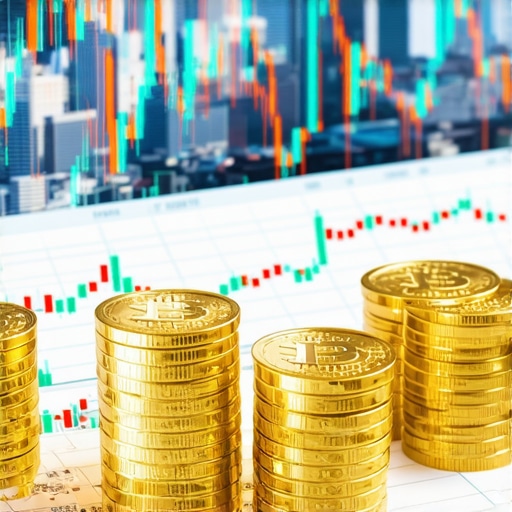Understanding the Impact of Central Bank Purchases on Gold Prices
The relationship between central bank purchases and gold price trends is a critical area of interest for investors and economists alike. As global economies fluctuate, central banks often turn to gold as a safe haven asset, influencing its market dynamics significantly. This article delves into how these purchases can affect gold prices, providing insights for those considering investments in this precious metal.
The Role of Central Banks in Gold Markets
Central banks hold gold as part of their foreign reserves, which serve several purposes, including stabilizing the economy and managing inflation. When central banks increase their gold holdings, it typically signals confidence in the asset, which can lead to higher gold prices. For instance, during times of economic uncertainty, such as inflationary periods or geopolitical tensions, central banks may ramp up their gold purchases to hedge against potential market volatility.
Moreover, central banks are significant players in the gold market, accounting for a notable percentage of annual gold demand. According to recent statistics, central banks bought over 400 tons of gold in a single year, a trend that can substantially impact prices due to the simple economics of supply and demand.
Market Reactions to Central Bank Actions
The market often reacts swiftly to news regarding central bank activities related to gold. For example, announcements of increased purchases can lead to immediate price surges as investors rush to capitalize on perceived stability and security. Conversely, if a central bank were to announce a sell-off of gold reserves, this could lead to a decline in gold prices, as it might indicate a lack of confidence in the asset or a shift towards other investment vehicles.
Investors should keep a close eye on central bank trends, as these can offer predictive insights into future gold price movements. Understanding the broader economic context in which these purchases occur is crucial. For instance, central banks in emerging markets may increase their gold reserves to diversify away from the US dollar, especially in a climate of inflationary pressure or currency volatility.
Long-term Trends vs. Short-term Volatility
While central bank purchases can cause fluctuations in gold prices, the long-term trend often reflects broader economic factors. In a stable economic environment, the influence of central bank purchases may be less pronounced, whereas in times of crisis, their impact can be magnified. Therefore, investors should consider both short-term volatility and long-term trends when analyzing gold price movements.
In conclusion, the interaction between central bank purchases and gold prices is complex but vital for investors to understand. By monitoring these developments, investors can better position themselves in the market, making informed decisions based on the current economic climate and central bank strategies. For more insights into gold investments, consider exploring our article on the role of gold as an inflation hedge.
Analyzing Gold Demand Trends: What Drives Prices
Understanding gold demand trends is essential for investors looking to make informed decisions. Several factors play a crucial role in shaping these trends, including economic conditions, geopolitical events, and changes in investor behavior. The demand for gold can fluctuate based on global economic stability, with periods of uncertainty often prompting increased investment in gold as a safe haven asset.
Economic Indicators Influencing Gold Demand
Key economic indicators such as inflation rates, interest rates, and currency strength can significantly affect gold demand. For instance, rising inflation often leads investors to seek gold as a hedge, which can boost its prices. On the other hand, when interest rates are high, the opportunity cost of holding gold increases, potentially reducing demand. Investors should be keenly aware of these dynamics when evaluating gold as part of their investment portfolio.
Geopolitical Events and Their Impact on Gold Prices
Geopolitical tensions, such as conflicts or trade disputes, can create a surge in gold demand as investors flock to the metal for security. Historical evidence suggests that during times of political unrest, such as wars or elections in major economies, gold prices tend to rise sharply. This reaction is rooted in the perception of gold as a stable asset amidst chaos, leading to increased demand and higher prices.
The Importance of Gold in a Diversified Investment Portfolio
Incorporating gold into an investment portfolio can provide several benefits, particularly in times of market volatility. Gold not only acts as a hedge against inflation but also offers diversification, reducing overall portfolio risk. By holding a mix of asset classes, including gold, investors can enhance the resilience of their portfolios against market fluctuations.
Gold as a Hedge Against Economic Downturns
During economic downturns, gold often outperforms other asset classes, making it a valuable addition to any investment strategy. The historical performance of gold during recessions highlights its role as a safe haven. Investors seeking to protect their wealth during turbulent times should consider increasing their gold holdings, as it tends to retain value better than stocks or bonds.
Evaluating Gold Investment Options
Investors have various options when it comes to investing in gold, including physical gold, gold ETFs, and gold mining stocks. Each option has its advantages and considerations. For example, physical gold offers tangibility and can be a reliable store of value, while gold ETFs provide liquidity and ease of trading. Understanding the nuances of each investment type is crucial for making informed decisions that align with one’s financial goals.
For those interested in exploring gold ETFs, our article on effective gold ETFs can provide valuable insights. Additionally, considering the performance of gold mining stocks can also be beneficial, as outlined in our post on investing in gold mining stocks. By assessing the various avenues for gold investment, investors can strategically position themselves in the market.
Exploring Different Gold Investment Strategies
As the gold market continues to evolve, investors must adapt their strategies to maximize returns. Understanding various gold investment strategies can empower investors to navigate the complexities of the market effectively. Whether you’re a novice or a seasoned investor, knowing the right approach can lead to significant financial benefits.
Physical Gold vs. Gold ETFs: Making the Right Choice
Investors often grapple with the decision of investing in physical gold or opting for gold ETFs. Physical gold, including coins and bars, provides a tangible asset that can be stored securely. However, the costs associated with storage and insurance must be considered. In contrast, gold ETFs offer liquidity and ease of trading, making them an appealing option for many. Understanding the differences between these two forms of investment is crucial for aligning your strategy with your financial goals.
Gold Mining Stocks: A Potentially Lucrative Investment
Another avenue for gold investment is through gold mining stocks. Investing in mining companies can yield high returns, especially if the price of gold rises. However, these stocks can be volatile, influenced by both gold prices and the operational efficiency of the companies. Therefore, conducting thorough research and understanding the mining sector is essential for those looking to invest in gold mining stocks. For insights on this topic, consider reading our post on investing in gold mining stocks.
The Role of Gold in Inflation Hedging
Gold is widely regarded as an effective hedge against inflation. As the cost of living rises, the value of currency often diminishes, making gold a more attractive investment option. During periods of high inflation, investors typically flock to gold, driving up its price. Understanding this relationship can help investors make informed decisions about when to buy or sell gold as part of their overall investment strategy.
Global Economic Trends and Their Influence on Gold
Monitoring global economic trends is vital for predicting gold demand. Factors such as changes in interest rates, economic growth or contraction, and geopolitical tensions can all impact gold prices. For instance, when economic uncertainty looms, gold often becomes a safe haven, resulting in increased demand. Staying informed about these trends can provide investors with a competitive advantage in the gold market.
Utilizing Gold as a Portfolio Diversifier
Incorporating gold into a diversified investment portfolio can enhance stability and reduce risk. Gold typically moves inversely to stocks, meaning that when stock markets decline, gold prices may rise. This inverse relationship can protect investors during economic downturns. By balancing gold with other asset classes, investors can create a robust investment strategy that withstands market fluctuations.
For more insights on diversifying your portfolio with gold, check out our article on the importance of gold in a diversified investment portfolio. Understanding how to blend gold investments with other assets can lead to a more resilient financial future.
Strategies for Long-Term Gold Investment Success
Investing in gold requires a strategic approach to ensure long-term success. Many investors wonder how to optimize their gold portfolio to achieve maximum returns. By implementing advanced strategies and staying informed about market trends, investors can enhance their gold investment performance.
Understanding Gold Demand Fluctuations
One of the key factors to consider in gold investing is the fluctuation in demand. Gold prices are heavily influenced by various factors such as industrial demand, jewelry consumption, and investment trends. For instance, during economic uncertainty, investment demand for gold typically increases, driving prices higher. Monitoring these demand trends can help investors time their purchases more effectively. To delve deeper into this topic, check our analysis on analyzing gold demand trends.
The Impact of Central Bank Policies on Gold Prices
Central banks play a significant role in shaping gold prices through their monetary policies and gold reserves management. When central banks increase their gold holdings, it often signals confidence in gold as a stable asset. Conversely, selling off gold reserves can lead to price declines. Investors should keep a close eye on central bank activities and their implications for gold prices. For further insights, refer to our article on the role of gold in inflation hedging.
Implementing Tactical Gold Trading Techniques
For those interested in actively trading gold, employing tactical trading techniques can be beneficial. Day trading, swing trading, and options trading are popular methods that allow investors to capitalize on short-term price movements. Understanding market indicators and trends is crucial for successful trading. Additionally, using tools such as stop-loss orders can help mitigate risks in volatile markets.
Utilizing Technical Analysis for Gold Trading
Technical analysis involves studying price charts and historical data to forecast future price movements. By identifying patterns and trends, investors can make more informed trading decisions. Common technical indicators include moving averages, RSI, and MACD. For investors looking to enhance their trading skills, mastering technical analysis can provide a competitive edge in the gold market. To learn more about trading techniques, explore our guide on gold trading techniques for newbies.
Leveraging Gold Futures for Investment Growth
Gold futures contracts are another avenue for investors seeking to profit from gold without holding the physical asset. These contracts allow investors to agree on a price for gold to be delivered at a future date, enabling them to speculate on price movements. However, futures trading requires a solid understanding of market dynamics and risk management strategies to avoid potential losses. For insights into how gold futures impact market dynamics, check out our article on how gold futures impact market dynamics.
Comprehensive FAQ Section on Gold Investment
What are the main benefits of investing in gold?
Investing in gold offers several advantages, including its role as a hedge against inflation, currency devaluation, and economic uncertainty. Gold typically retains its value over time, making it a safe haven during market volatility.
How can I start investing in gold?
To start investing in gold, you can choose various methods such as purchasing physical gold (coins or bars), investing in gold ETFs, or buying shares in gold mining companies. It’s essential to research and select the option that aligns with your investment goals and risk tolerance.
What factors influence gold prices?
Gold prices are influenced by several factors, including supply and demand dynamics, geopolitical tensions, interest rates, and inflation rates. Additionally, market sentiment and central bank policies can significantly impact gold prices.
Is gold a good long-term investment?
Yes, gold is considered a good long-term investment due to its historical performance and ability to provide stability in an investment portfolio. It often acts as a counterbalance to more volatile assets like stocks.
What are the risks associated with gold investment?
The risks of investing in gold include price volatility, storage costs for physical gold, and potential liquidity challenges. Investors should be aware of these risks and implement strategies to mitigate them.
How often should I review my gold investment portfolio?
It’s advisable to review your gold investment portfolio at least annually or during significant market changes. Regular reviews allow you to adjust your strategy based on current market conditions and your investment goals.
Can I invest in gold through my retirement account?
Yes, you can invest in gold through certain retirement accounts, such as a Self-Directed IRA. This allows you to invest in physical gold and other precious metals while enjoying tax advantages.
What are gold ETFs, and how do they work?
Gold ETFs (Exchange-Traded Funds) are investment funds that track the price of gold. They allow investors to gain exposure to gold without having to physically own it. Investors can buy and sell shares of gold ETFs on stock exchanges like regular stocks.
How do I choose the best gold investment strategy for me?
Choosing the best gold investment strategy depends on your financial goals, risk tolerance, and investment timeline. Research different methods, consider expert advice, and assess your overall investment strategy to make an informed decision.
What resources can I use to stay updated on gold market trends?
Staying updated on gold market trends can be achieved by following reputable financial news websites, subscribing to market analysis reports, and engaging with investment communities. Trusted sources include financial publications, expert blogs, and investment seminars.
Authority Resources for Gold Investment Insights
For further learning and to enhance your gold investment knowledge, consider exploring these authoritative resources:
- World Gold Council – Provides in-depth research and information on gold market trends.
- Investopedia – Offers educational articles on various investment strategies, including gold.
- Kitco Metals – A trusted source for gold prices and market news.
- Bloomberg – Provides comprehensive financial news and analysis, including gold market insights.
- Forbes – Features expert opinions and articles on gold investing and market trends.
Conclusion: Your Path to Gold Investment Mastery
Investing in gold can be a rewarding venture when approached with the right strategies and knowledge. By understanding market dynamics, implementing effective trading techniques, and staying informed through reliable resources, you can enhance your investment portfolio and secure your financial future. Remember, gold serves not only as a hedge against inflation but also as a means to diversify your assets. With the information and insights provided in this article, you are now better equipped to navigate the gold investment landscape.











The post provides a thorough look at how central bank purchases influence gold pricing, which is indeed a complex but fascinating topic. I’ve noticed in my own investment experience that central bank activities often act as a leading indicator for gold market trends, especially during times of inflation or geopolitical tension. One aspect that stood out is how emerging markets increase gold reserves to diversify away from the US dollar—this seems especially relevant today given ongoing currency fluctuations globally. However, what intrigues me most is balancing the short-term volatility caused by these purchases with the broader long-term economic factors. For example, how do seasoned investors factor central bank gold buying trends into their strategies without overreacting to sudden price spikes? Additionally, considering gold’s role as an inflation hedge, it would be interesting to hear how others approach timing their gold investments in response to central bank announcements or shifts in economic indicators. Has anyone developed reliable methods for interpreting central bank behavior to optimize investment timing? I think discussing such tactical approaches could provide valuable insight for both novice and seasoned investors alike.
Melanie raises a really nuanced question about balancing short-term volatility from central bank gold purchases with longer-term economic trends. From my experience, one useful approach is to view central bank buying not as an isolated trigger but within the broader macroeconomic context. For example, if a central bank is increasing gold reserves amid rising inflation and geopolitical uncertainty, that generally confirms gold’s role as a hedge and may justify increasing exposure cautiously. However, reacting too strongly to single announcements can backfire due to market overreactions and short-term spikes.
Monitoring trends over several months and combining that with economic indicators like inflation rates, currency stability, and geopolitical developments offers a more stable foundation for timing. I’ve also found it helpful to include technical analysis to gauge price momentum before making moves. Another point is recognizing that emerging markets shifting away from the US dollar to gold is part of a larger currency diversification strategy, often signaling a longer-term trend rather than a flash event.
I’m curious how others factor in central bank signals while accounting for market noise. Have you found particular economic indicators or timing strategies that help you avoid knee-jerk reactions but still capitalize on meaningful gold price movements?